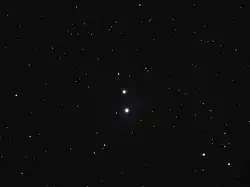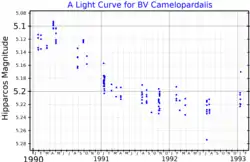| Observation data Epoch J2000.0 Equinox J2000.0 | |
|---|---|
| Constellation | Camelopardalis |
| Right ascension | 05h 06m 08.45273s[2] |
| Declination | +58° 58′ 20.5432″[2] |
| Apparent magnitude (V) | 5.08[3] |
| Characteristics | |
| Spectral type | B3 Ve[4] |
| B−V color index | −0.080[5] |
| Variable type | Be[6] |
| Astrometry | |
| Proper motion (μ) | RA: −6.264[2] mas/yr Dec.: −7.118[2] mas/yr |
| Parallax (π) | 4.7543 ± 0.1224 mas[2] |
| Distance | 690 ± 20 ly (210 ± 5 pc) |
| Absolute magnitude (MV) | −1.38[5] |
| Details | |
| Mass | 6.0±1.2[7] M☉ |
| Radius | 7.87[8] R☉ |
| Luminosity | 1,766+131 −122[7] L☉ |
| Surface gravity (log g) | 4.00±0.35[7] cgs |
| Temperature | 17,240±560[7] K |
| Rotational velocity (v sin i) | 95±6[7] km/s |
| Age | 25±3[9] Myr |
| Other designations | |
| Database references | |
| SIMBAD | data |

11 Camelopardalis is a single[11] star in the northern circumpolar constellation of Camelopardalis, located around 690 light years away from the Sun as determined by parallax. It has the variable star designation BV Camelopardalis; 11 Camelopardalis is the Flamsteed designation. This object is visible to the naked eye as a faint, blue-white hued star with a baseline apparent visual magnitude of +5.22.[5] It forms a double star with 12 Camelopardalis, which is only 3 arcminutes away.
This is a main sequence Be star with a stellar classification of B3 Ve.[4] Samus et al. (2017) classify it as a Be variable, rather than a Gamma Cassiopeiae type, and it ranges from a peak Hipparcos magnitude of 5.10 down to 5.22.[6] The star is spinning with a projected rotational velocity of 95 km/s,[7] but is being viewed from an extreme pole-on position. Hence it is spinning much more rapidly than indicated. Outbursts of hydrogen emission lines have been observed, as well as rapid changes in hydrogen line profiles.[12] It is 25[9] million years old with around six[7] times the mass of the Sun.
References
- ↑ "Hipparcos Tools Interactive Data Access". Hipparcos. ESA. Retrieved 8 December 2021.
- 1 2 3 4 5 Vallenari, A.; et al. (Gaia collaboration) (2023). "Gaia Data Release 3. Summary of the content and survey properties". Astronomy and Astrophysics. 674: A1. arXiv:2208.00211. Bibcode:2023A&A...674A...1G. doi:10.1051/0004-6361/202243940. S2CID 244398875. Gaia DR3 record for this source at VizieR.
- ↑ "BV Cam", International Variable Star Index, AAVSO, retrieved 2022-07-26.
- 1 2 Slettebak, A. (1982), "Spectral types and rotational velocities of the brighter Be stars and A-F type shell stars", Astrophysical Journal Supplement Series, 50: 55, Bibcode:1982ApJS...50...55S, doi:10.1086/190820.
- 1 2 3 Anderson, E.; Francis, Ch. (2012), "XHIP: An extended hipparcos compilation", Astronomy Letters, 38 (5): 331, arXiv:1108.4971, Bibcode:2012AstL...38..331A, doi:10.1134/S1063773712050015, S2CID 119257644.
- 1 2 Samus, N. N.; et al. (2017), "General Catalogue of Variable Stars", Astronomy Reports, 5.1, 61 (1): 80–88, Bibcode:2017ARep...61...80S, doi:10.1134/s1063772917010085, S2CID 125853869.
- 1 2 3 4 5 6 7 Zorec, J.; et al. (November 2016), "Critical study of the distribution of rotational velocities of Be stars. I. Deconvolution methods, effects due to gravity darkening, macroturbulence, and binarity", Astronomy & Astrophysics, 595: 26, Bibcode:2016A&A...595A.132Z, doi:10.1051/0004-6361/201628760, hdl:11336/37946.
- ↑ Kervella, Pierre; Arenou, Frédéric; Thévenin, Frédéric (2022). "Stellar and substellar companions from Gaia EDR3. Proper-motion anomaly and resolved common proper-motion pairs". Astronomy and Astrophysics. 657: 657. arXiv:2109.10912. Bibcode:2022A&A...657A...7K. doi:10.1051/0004-6361/202142146. S2CID 237605138.
- 1 2 Tetzlaff, N.; et al. (January 2011), "A catalogue of young runaway Hipparcos stars within 3 kpc from the Sun", Monthly Notices of the Royal Astronomical Society, 410 (1): 190–200, arXiv:1007.4883, Bibcode:2011MNRAS.410..190T, doi:10.1111/j.1365-2966.2010.17434.x, S2CID 118629873.
- ↑ "11 Cam". SIMBAD. Centre de données astronomiques de Strasbourg. Retrieved 2019-04-15.
- ↑ Eggleton, P. P.; et al. (September 2008), "A catalogue of multiplicity among bright stellar systems", Monthly Notices of the Royal Astronomical Society, 389 (2): 869–879, arXiv:0806.2878, Bibcode:2008MNRAS.389..869E, doi:10.1111/j.1365-2966.2008.13596.x, S2CID 14878976.
- ↑ Ballereau, D.; et al. (May 1987), "Hα echelle spectroscopy of Be stars: an atlas.", Revista Mexicana de Astronomía y Astrofísica, 15 (1): 29–52, Bibcode:1987RMxAA..15...29B.
